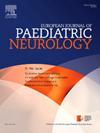glycopyronium治疗小儿流口水的来龙去脉:利用真实世界的数据探索治疗之旅
IF 2.3
3区 医学
Q3 CLINICAL NEUROLOGY
引用次数: 0
摘要
抗胆碱能药物是治疗小儿流口水的重要选择。我们探讨了glycopyronium的实际应用,这是一种注册用于儿科人群的抗胆碱能药物,重点关注治疗模式、有效性和影响、药物不良反应(adr)和护理人员满意度。方法对2020年11月至2024年2月在我院三级儿童医院新接受glycopyronium治疗前/后流口水的22例儿童(3-18岁)进行纵向观察研究。我们评估了流口水严重程度的口头数字评定量表、流口水严重程度和频率量表(DSFS)、唾液控制的表现和满意度测量(MPS)、不良反应的发生率和剂量调整。结果基线时,流口水多,频繁至持续发生。大多数儿童(86%)每天服用三次吡氯硝铵,剂量滴定适合每个儿童,药物主要与食物一起给药(56%)。在第一次随访预约时,DSFS的临床重要降低为53%。相应的,MPS评分中位数从基线时的0.0增加到随访时的5.6 (p < .001)(0 =不干;10 =完全干),表明在流口水影响的情况下,唾液控制得到改善。73%的患者报告了不良反应,36%的患者停止治疗,主要是由于胃肠道问题和行为改变。结论本研究结果证实了glycopyronium在实际条件下的适用性,补充了更严格设计的研究结果。对剂量滴定、给药时间、效果或不良反应随时间变化的个体差异的见解,突出了量身定制治疗方法的相关性。本文章由计算机程序翻译,如有差异,请以英文原文为准。
The ins and outs of glycopyrronium treatment for paediatric drooling: exploring the treatment journey using real-world data
Introduction
Anticholinergic medication is an important treatment option for paediatric drooling. We explored the practical application of glycopyrronium, an anticholinergic medicine registered for the paediatric population, focusing on treatment patterns, effectiveness and impact, adverse drug reactions (ADRs), and caregiver satisfaction.
Methods
A longitudinal, observational study was performed, including 22 children (3–18 years) newly treated with glycopyrronium for anterior and/or posterior drooling in our tertiary children's hospital between November 2020 and February 2024. We assessed a verbal numerical rating scale for drooling severity, Drooling Severity and Frequency Scale (DSFS), Measure of Performance and Satisfaction for Saliva Control (MPS), prevalence of ADRs, and dosage adjustments.
Results
At baseline, drooling was typically profuse and occurred frequently to constantly. The majority of children (86 %) took glycopyrronium thrice daily, with dose titration tailored to each child and medication primarily administered with food (56 %). A clinically important reduction in DSFS was observed in 53 % at the first follow-up appointment. Correspondingly, median MPS scores increased from 0.0 at baseline to 5.6 at follow-up (p < .001) (0 = not dry; 10 = perfectly dry), indicating improved saliva control in situations impacted by drooling. ADRs were reported in 73 %, leading to treatment cessation in 36 %, primarily due to gastrointestinal issues and behavioural changes.
Conclusions
Our findings confirm the applicability of glycopyrronium under real-world conditions, complementing results from studies with more rigid designs. Insights into inter-individual differences in dose titration, timing of medication administration, and changes in effect or ADRs over time highlight the relevance of a tailored treatment approach.
求助全文
通过发布文献求助,成功后即可免费获取论文全文。
去求助
来源期刊
CiteScore
6.30
自引率
3.20%
发文量
115
审稿时长
81 days
期刊介绍:
The European Journal of Paediatric Neurology is the Official Journal of the European Paediatric Neurology Society, successor to the long-established European Federation of Child Neurology Societies.
Under the guidance of a prestigious International editorial board, this multi-disciplinary journal publishes exciting clinical and experimental research in this rapidly expanding field. High quality papers written by leading experts encompass all the major diseases including epilepsy, movement disorders, neuromuscular disorders, neurodegenerative disorders and intellectual disability.
Other exciting highlights include articles on brain imaging and neonatal neurology, and the publication of regularly updated tables relating to the main groups of disorders.

 求助内容:
求助内容: 应助结果提醒方式:
应助结果提醒方式:


